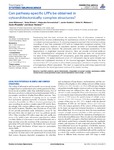Mostrar o rexistro simple do ítem
Can pathway-specific LFPs be obtained in cytoarchitectonically complex structures?
| dc.contributor.author | Marakova, Julia | |
| dc.contributor.author | Ortuño Silva, Tania | |
| dc.contributor.author | Korovaichuk, Alejandra | |
| dc.contributor.author | Cudeiro, Javier | |
| dc.contributor.author | Marakov, Valeri A. | |
| dc.contributor.author | Rivadulla, Casto | |
| dc.contributor.author | Herreras, Oscar | |
| dc.date.accessioned | 2015-06-08T11:09:27Z | |
| dc.date.available | 2015-06-08T11:09:27Z | |
| dc.date.issued | 2014-05-01 | |
| dc.identifier.citation | Marakova J, Ortuño T, Korovaichuk A, Cudeiro J, Marakov VA, Rivadulla C, Herreras O. Can pathway-specific LFPs be obtained in cytoarchitectonically complex structures?. Front Syst Neurosci. 2014;8:66. | es_ES |
| dc.identifier.uri | http://hdl.handle.net/2183/14641 | |
| dc.description.abstract | [Abstract] Deciphering how the brain encodes the continuous flow of information contained in natural stimuli requires understanding the spontaneous activity of functional assemblies in multiple neuronal populations. A promising integrative approach that combines multisite recordings of local field potentials (LFP) with an independent component analysis (ICA) enables continuous readouts of population specific activities of functionally different neuron groups to be obtained. We previously used this technique successfully in the hippocampus, a single-layer neuronal structure. Here we provide numerical evidence that the cytoarchitectonic complexity of other brain structures does not compromise the value of the ICA-separated LFP components, given that spatial sampling of LFP is representative. The spatial distribution of an LFP component may be quite complex due to folded and multilayered structure of the neuronal aggregate. Nevertheless, the time course of each LFP component is still a reliable postsynaptic convolution of spikes fired by a homogeneous afferent population. This claim is supported by preliminary experimental data obtained in the lateral geniculate nucleus of the awake monkey. | es_ES |
| dc.description.sponsorship | This work was supported by Grants BFU2010-19192, BFU2009-08169 and FIS2010-20054 from the former Spanish Ministry of Science and Innovation. We thank Mark Sefton at BiomedRed for editorial support. | |
| dc.description.sponsorship | info:eu-repo/grantAgreement/MICINN/Programa Nacional de Investigación Fundamental/BFU2010-19192/ES/EXTRACCION DE FUENTES DE ACTIVIDAD NEURAL PROFUNDA CON TECNICAS DE SEPARACION CIEGA DE FUENTES | |
| dc.description.sponsorship | info:eu-repo/grantAgreement/MICINN/Programa Nacional de Investigación Fundamental/BFU2009-08169/ES/Papel De Las Conexiones Feedback En El Procesamiento Visual | |
| dc.description.sponsorship | info:eu-repo/grantAgreement/MICINN/Programa Nacional de Investigación Fundamental/FIS2010-20054/ES/MODELIZACION TEORICO-EXPERIMENTAL DE REDES NEURONALES IMPLICADAS EN PROCESOS COGNITIVOS | |
| dc.language.iso | eng | es_ES |
| dc.publisher | Frontiers | es_ES |
| dc.relation.uri | http://dx.doi.org/10.3389/fnsys.2014.00066 | es_ES |
| dc.rights | Creative Commons Attribution 4.0 International Licence (CC-BY 4.0) | |
| dc.rights.uri | http://creativecommons.org/licenses/by/4.0/ | |
| dc.subject | Local field potentials | es_ES |
| dc.subject | Spatial discrimination | es_ES |
| dc.subject | Independent component analysis | es_ES |
| dc.subject | Spontaneous activity | es_ES |
| dc.subject | Network activity | es_ES |
| dc.subject | Lateral geniculate nucleus | es_ES |
| dc.subject | Multicompartmental neuron model | es_ES |
| dc.subject | LFP model | es_ES |
| dc.title | Can pathway-specific LFPs be obtained in cytoarchitectonically complex structures? | es_ES |
| dc.type | info:eu-repo/semantics/article | es_ES |
| dc.rights.access | info:eu-repo/semantics/openAccess | es_ES |
Ficheiros no ítem
Este ítem aparece na(s) seguinte(s) colección(s)
-
GI-NEURO - Artigos [132]
-
INIBIC-NEURO - Artigos [48]






